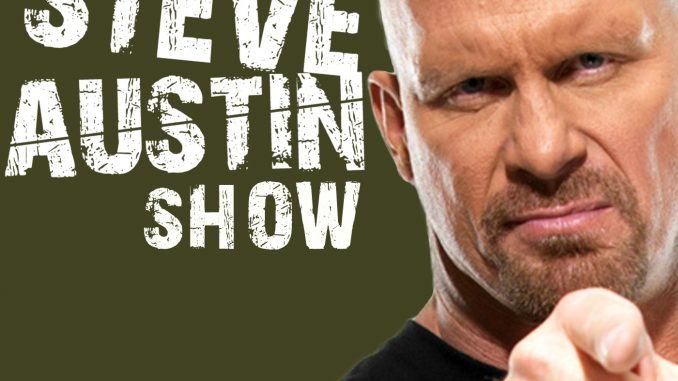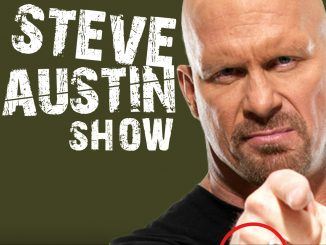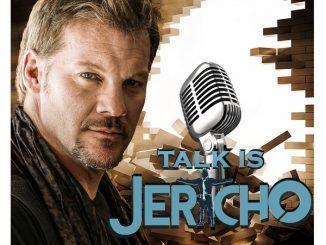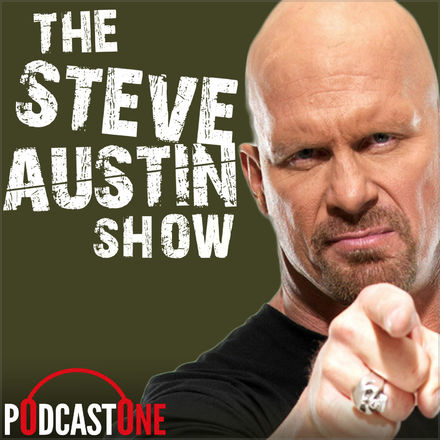
The Steve Austin Show
Release Date: January 2, 2018
Recap by: Joe Aguinaldo
DIRECT LINK TO LISTEN/DOWNLOAD
Before getting into this…I wanted to wish everyone a Happy New Year. All the best to you in 2018. OK…onto the podcast recap.
0:00 – Intro
Steve starts off talking about the college football games as he is a huge fan of the sport. He just finished watching UCF beat Auburn and will be watching Oklahoma vs. Georgia and Alabama vs Clemson. He congratulates Scott Frost for his work at UCF. Frost will be going to Nebraska next year and Austin hopes Frost can bring them back to prominence in college football. He also hopes Tom Herman does well with the Texas Longhorns next year and hopes he can turn that program around.
Austin wants to keep the open of the show short but wishes everyone a Happy New Year. He thanks his fans for listening to his show. Coming up on today’s podcast is part one of his conversation with his long time friend Al Snow. Austin met Al a long time ago and puts him over as a knowledgeable guy. He likes Al’s views and spin on pro wrestling and says he is one of the better trainers he knows. Steve says the interview will just be them shooting the breeze. Steve mentions Al’s new clothing line called Collar and Elbow (www.collarandelbowbrand.com).
7:35 – Al Snow
Steve welcomes Al to the show and asks what he’s up to. Al is currently in Louisville Kentucky and was working as a producer in TNA but parted ways with them in June. He has started negotiations with a company over in Malaysia who will be running shows in parts of Asia called Asian Wrestling Entertainment. They want Al to be the head trainer and head producer. Al mentions there is a huge market in Asia for pro wrestling that is largely untapped.
Steve asks about Al’s training training schools. Al has a number of training academies located in Europe and South America. He talks about his schools and that philosophically, everyone will be learning the same way. He says the key to wrestling is experience and wrestling as much as you can in front of as many different audiences as you can. If you go to his school in England and have gone as far as you can go, you can call Chile and work in front of a completely different audience. The philosophy of both schools will be the same but you would learn new technique and styles in order to wrestle in front of different audiences.
Steve and Al get into discussions about wrestling styles. Al uses the example of World of Sport and how the technical style evolved because the censors did not want violence on TV. Al says that overall, current styles are dictated by the WWE. Al disagrees with the sentiment that the business is changing. He feels this is an excuse or justification for lazy psychology or lackadaisical work. He also says ‘working’ has nothing to do with physical or athletic ability but rather it’s about working the audience and giving the audience what they’ve paid to believe, which is that wrestling is a competition and the outcome has some gravity to it. The wrestlers are prize fighters that are trying to win and not just put out a physical performance. Al says the wrestlers have gotten far away from that concept.
Even though they say the business has changed, Al argues it is still presented as a competition with a referee and championship matches. He also says despite what wrestlers may say about physical performances, they still care if they win or lose. He also says that even though people know that wrestling has been pre-determined since the 1940s and they still pay to see it.
Steve and Al get into a discussion about selling. Steve mentions some interviews Al did a few years ago and Al said that wrestlers weren’t selling. Austin says that in today’s product, the guys are overselling, ,which is one of his pet peeves. Al adds that the current wrestlers are overselling because they don’t know what selling is. Al thinks wrestlers today are selling that they are hurt rather than selling the finish of the match and that you could actually lose the match because you are vulnerable.
Al also disagrees that kayfabe is dead and that it’s only dead because the wrestlers killed it. He brings up Matt Hardy and why the Broken character got over so well. Matt never broke character and he never gave the audience anything other than the Broken character and that’s what the audience wants. The audience wants to pay to believe and the two most important things the audience wants are to believe in who you are and believe why you did what you do in the ring. This is what you should be selling.
Steve and Al briefly discuss the Hardy Boys and the development of the Broken character. Al says the most important thing to develop in wrestling is to have a definable character that an audience member can easily describe to a friend or family member in a sentence. If they can’t describe your character, it doesn’t matter how physically talented you are, you can’t generate interest in your character. Al uses Matt Hardy again as an example of how defining a character can generate interest.
Steve asks Al about how he teaches the wrestlers at his school the concept of character development. Al says he first teaches his students how to actually wrestle and how to protect yourself and the other person. Al says that guys today are not taught how to take a bump for someone but rather how to give a bump to someone. Al says that you should never give a bump to a person but do a move and let the person take the bump for you and make you look good. He brings up a great story about Owen Hart teaching Lex Luger a lesson in the ring about how someone taking a bump for you can make you look good or crap (definitely take a listen to this story as it’s a great learning tool. It happens at 23:22 of the podcast).
Austin segues into Lex Luger and talks about the Lex Express and how the gimmick did not work. Austin and Al both agree that Vince gives everyone an opportunity. Austin asks Al about the Head gimmick and what it taught him. Al says much of his learning has been through experience and making mistakes. He says wrestling is not a ‘job’ but is a partnership between the wrestler and Vince McMahon.
Regardless of where you are on the card, Vince gives you a platform but it’s up to the performer to create something that Vince can exploit, move you up the card and something that makes money for both of you. Al thinks one of the downfalls of wrestling is the downside guaranteed contract, which is something the wrestlers are afraid to lose. Today’s wrestlers don’t perform to make themselves attractions or to get themselves over, rather, they play it safe because they don’t want to upset anyone or get heat and get ‘fired.’ Al says that if they use that WWE platform to get over, even if they get fired from the WWE, they can still go out and make money elsewhere and utilize that to get over and reinvent themselves for Vince to bring back again. He brings up Matt Hardy again as an example.
Al brings up his initial run in the WWE. Prior to coming to the WWE, he was a heel in all the territories he worked. When he came to WWE he was given a masked babyface gimmick that did not get over and then the New Rockers gimmick. He also talks about conversations he had with Vince about doing vignettes for his masked gimmick, which did not end up happening and blames himself for not working harder to get that gimmick over. He also mentions when the New Rockers gimmick was ending, he was back at trying to figure out a character. After a conversation with Chris Candido, he knew he had to go some place else to get over on someone else’s TV so the WWE would see him and bring him back.
When Al went to ECW, his mindset was to get over. When he finally got over he was expecting to be a heel but was over as a babyface, which he did not quite understand. However, because he had gotten over so much, Vince decided to take him back. Al says it’s important to have a relationship with Vince which he did not have as he was of an old school mindset of ‘the boys vs the office.’ He talks about the original story line about the Head gimmick and says because he never had that relationship to Vince, he never explained it to Vince and Vince never understood the gimmick. Steve agrees that you have to have a relationship with Vince and tells a story about how his relationship with Vince started.
Steve says that as someone move up in the business or if they work a lot with Vince, they become more important to the point of becoming best friends or at least best business partners with Vince. Al adds that as the next person comes up, you start to fade as that person comes forward, which is the way the business works. Al says that Vince will talk to anyone who is willing to talk business. He also talks about the glass ceiling and admits that there are politics in wrestling as the environment is ultra competitive. But he adds that Vince wants everyone to get over because the more people who are over, the more successful they are and the more business they do.
Austin recalls a story of watching a Steve Blackman match at Madison Square Gardens. The crowd popped for Blackman and Austin mentioned that to Vince. Vince responded back that he hoped Blackman could get over. Al mentions that the term pop is misused in wrestling today. It doesn’t mean to make noise, it’s supposed to mean pop a nut. Al says that the minute you walk through the curtain and in the ring, there is nothing that Vince or anyone else can do to stop you or help you.
Austin asks Al if he watches the current product and Al says he watches occasionally but doesn’t want wrestling to define who he is. This is a lesson he learned from Sandy Scott, who used to complain that Al and Brian Hildebrandt used to watch wrestling all the time. Steve says he was all about the business and everything else was second.
Steve feels that the product today is micromanaged and people are walking on eggshells because there are fewer places to work. He says it is possible to get over in a micromanaged environment, however, he says that they had more leeway back in the day to push the envelope compared to today because of the ability to go to more territories. Snow adds he and Austin came from a time when they wrestled for a living. He says when you have to wrestle for a living to pay bills, your mindset is completely different. You don’t necessarily care if you had a good match, you care more about how many people came to the show.
Al lists out a number of legendary promoters he worked for over the years such as Verne Gagne, Dick the Bruiser, and the Sheik and says not one time did anyone of them ask him how his match was. They were only interested on how many people were in the house. Additionally, those promoters would determine how much of a factor Al was in drawing the house, because if he wasn’t a factor, he wouldn’t get booked again. Al also says that when he was wrestling in the territories, he had to do something to either be the thing that sold tickets or be something that helped sell tickets.
Al tells a story about Dick the Bruiser explaining a $10 payoff after a card (47:10 into the podcast). Al also tells a great story about giving advice to his daughter’s boyfriend regarding getting booked and payoffs (48:02 into the podcast). The lesson of the story is that the drive or need isn’t there for wrestlers to get over during the shows. Austin says he thinks the drive is there but the sense of urgency is different compared to what it was in the past. Austin talks about his early career and says it was a different era where it was ingrained you had to kick, scratch, and claw for your position. Al adds that it’s a different experience for the guys today because they did not have the experience of having to scratch and claw for their spot. He feels this is a reason why the talent is micromanaged whereas those that had that experience were given more free reign to develop their characters.
Austin brings up a match Al had 3 years ago with Hannibal and puts over the psychology of the match. Austin asks if Al is still competing and Al says he is because he loves wrestling and still likes learning things. Al tells a story about a card at Cobo Hall where he fought Shane (Douglas I’m guessing) and thought about a way to make the match better by turning heel, although he didn’t do it. (54:20 into the podcast). Al says he still enjoys figuring out the business and trying different things out. Austin goes back to the match with Hannibal saying that it wasn’t the greatest match but Al had solid psychology, strategy and body language. Al talks about how to work as a heel and how to put a babyface over by making the babyface your car (57:54 into the podcast).
Austin asks how Al is feeling. Al says that something hurts everyday. Early in his careers, he ignored a lot of the veterans who told him to slow down. He realized later on wrestling hurts, it hurts a lot and will hurt for the rest of his life. Al talks about some of his some of his worst injuries. One was a broken neck, which he didn’t know about until a few years later after getting a CAT scan. He also had some concussions which led to two strokes that affected his ability to track time. Al says his memory is shaky at times and the issue with tracking time doesn’t help.
Austin asks Al if he can talk for another hour, as he will be shutting down this portion of the discussion. Austin queues up some of the topics for the second part of the discussion including his meeting with Al Snow to train at his wrestling academy and Jim Lancaster who initially trained Al. Before signing off, they plug Al’s new clothing line called Collar and Elbow Clothing which started in mid-July. The idea was to come up with a brand just for wrestling in the vein of Under Armor or Nike. The website is www.collarandelbowbrand.com and portions of every purchase goes to the Cauliflower Alley club to help support older wrestlers and boxers. Al is on social media @TheRealAlSnow on Twitter and Instagram. Steve teases the story about his Wrestlemania submission match with Bret Hart and Al’s involvement which they will pick up in part 2 of the discussion.
1:08:26 – Show wrap
Austin thanks Al Snow for being on the show and plugs part two of their conversation coming up Thursday. Austin recommends watching Al Snow vs. Hannibal from a few years ago.
Steve says it’s a good solid match and puts over Al’s mannerisms and how he tells a story in the match. Austin mentions a few other topics he’ll be talking about with Al Snow next show. He wishes everyone a Happy New year and that’s a wrap.
Show Rating 9/10
As a disclaimer to my show rating, I’ll admit that I love shows like this where they talk about the past and wrestling psychology. Al is very well spoken when explaining aspects of pro wrestling and his views on wrestling are interesting and resonated with the older fan in me. I timestamped some of the interesting stories and viewpoints during the podcast below and am definitely looking forward to part two of this interview.
Timestamps
0:00 – Intro
7:35 – Al Snow
23:22 – Owen Hart/Lex Luger story
47:10 – Dick the Bruiser story about payoffs
48:02 – Advice to his daughter’s boyfriend
54:20 – Al talks about still learning the business
57:54 – Working heel and how to get a babyface over
Writer Bio
Joe lives in Toronto, Canada with his wife and two boys. He’s been watching wrestling for about 40 years (give or take) but don’t consider himself any sort of expert, mark, smark or whatever term they use out there. He just likes wrestling. Check him out on twitter and instagram @ja113.




Be the first to comment